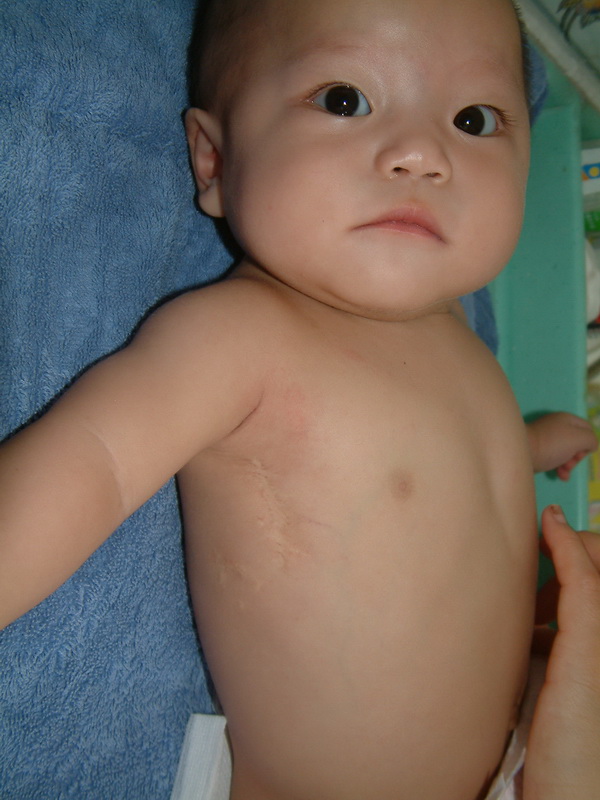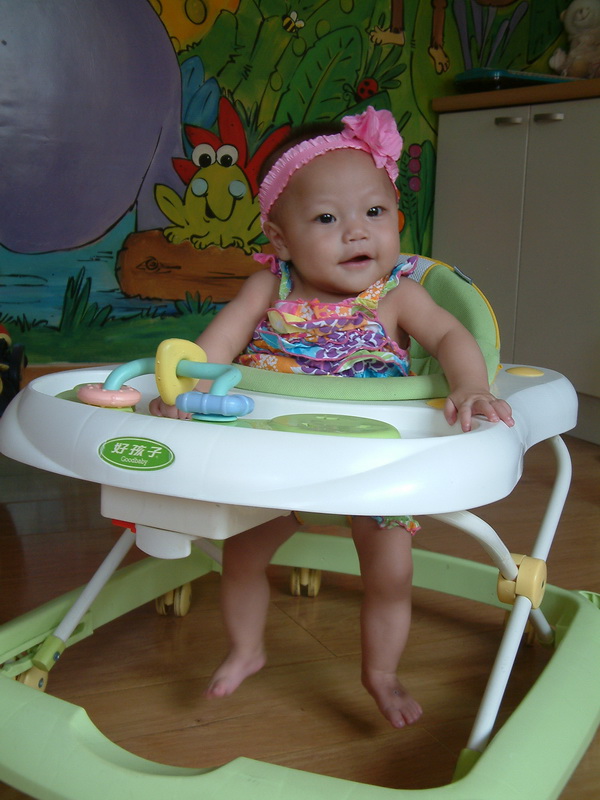I vividly remember reading our referral paperwork. I remember first reading the descriptions of her developmental milestones and evaluated her development through mom and teacher goggles… “she follows objects… she is tracking… she is grasping things… she is babbling and forming simple sounds… she turns her head when there is a noise… she can hear noises… she sleeps through the night… she eats biscuits… she laughs… she cries when seeing strangers… she is loved by her nanny.”
I remember pouring through the detailed medical information. Everything from head circumference to congenital heart defect to precisely where they made the incision for her repaired tracheo-esophageal fistula. I read about when it was done, where it was done, exam notes from while she was hospitalized, and discharge notes for her prognosis.
I can’t say if every referral file is as detailed as ours was, but it seemed to be ridiculously detailed. I felt like I knew more about this child, this daughter I loved but had not met – than I knew about the children I gave birth to! Pages upon pages of information gave me insight into her past, present, and hope for her future. It is a treasure to me now even more than it was then because it’s her story before we joined her life. It’s all I have to fill in the missing pieces, and yet even as we returned home there there was much more to be learned.
I remember mentally checking off the Tracheo-esophageal Fistula (TEF) as “complete”, a “non-issue”, thinking “We need not worry ourselves about that because – (hallelujah) – it has been repaired”. And it was repaired. It was repaired “with excellence and precision”, we would later be told by specialists here. Grace was three weeks old at the time of repair because that is a repair that has to come very quickly in order to survive. At the time she was found, this TEF – this connection between her trachea and esophagus, allowed whatever she drank to be shared by her esophagus and her trachea.
The esophagus leads to her stomach. The trachea leads to her lungs. Fluid should’t go to the lungs because that’ll make you very sick. The connection, the fistula, was removed and the places where it was attached were closed. You would think that would be the end of that special need. The file said, “Repaired”. Sometimes repairs leave evidence that there was a problem. Sometimes healing produces scar tissue and sometimes in order to fix one thing – you inevitably create new challenges.
So it goes with a TEF repair. Once repaired the trachea becomes compromised. It still functions but in most cases becomes “floppy” or is diagnosed as “tracheo-malacia”. When we met Grace she sounded cross between a sick seal, a babbling brook, and a veteran smoker in crisis. She was recovering from yet another bout of pneumonia but it was more than that. She was so very noisy. Noisy when she breathed, noisy when she laughed, noisy when she slept, and noisy when she ate. Leaving the less-than-
healthy China-air behind was probably the best medicine for her second only to her heart surgery.
Having a floppy trachea makes her more susceptible to infection. Things that should be easily expelled from our trachea isn’t always so easy for Grace, but – I hardly notice any noise any more; because there hardly is any noise any more. As she grows (and she’s growing) it is expected to improve and for as susceptible as she is to infection, she had only one in 11 months of being in the US. That is record-breaking for our little Grace. She is definitely one who defies the odds.
The esophagus on the other hand, is both friend and foe and we do battle daily. Meals are the most difficult time of the day because at 2 1/2 little miss thing wants to eat what we eat. She wants to feed herself the way we feed ourselves. She longs for independence in the area of self-feeding, and we can not fully give her that independence. Her esophagus narrows where her repair was. There is scar tissue, and while it isn’t narrow enough to dilate (according to our specialist) it’s narrow enough to make eating a challenge in this season of life. Foods like yogurt, apple sauce, crunchy crackers that she knows to chew well, toast with a very thin layer of peanut butter or cream cheese, and some soups, are our go-to foods. Normal toddler foods like any kind of meaty nugget, cut up fresh fruits or veggies, some cooked veggies, any potato product, bread, pasta, and any kind of mixed texture is risky for Grace. Choking happens in the trachea – so I don’t call what happens to Grace choking, but it’s similar. Food gets stuck. It gets stuck at the point of her narrowing and one of two things happens:
1.) what goes down comes back up (sometimes not right away)
2.) what goes down eventually….goes down.
In addition to the narrow point, there’s a second consequence from her repair. In you and I, the esophagus has a chain of nerves that squeezes food down in a rhythmic contraction of muscles called peristalsis. When that chain of nerves was interrupted during Grace’s TEF repair their function became limited. We don’t know how limited, we don’t know if the function will return aside from a heavenly healing; but we do know that once passed the point of her repair – we rely on gravity rather than her esophagus to move the food into her stomach. There is evidence of reflux at the bottom of her esophagus which she may or may not feel depending on the degree of nerve damage, so she is currently on a twice a day dose of liquid randitidine (generic Zantac). Will it always be this way? Only God knows. Nothing is impossible for Him so we pray often for healing. As she grows, though, and discoveres what we veteran eaters know to be true: 1. Take small bites. 2. Chew food well. 3. Swallow small bits at a time. 4. Take a drink to help move things a long – things will naturally be easier for her.
We monitor her closely at meal times but despite our best efforts there have been many scary moments, and yet it’s very manageable. It’s nothing we can’t handle and there has been noticeable improvement since we met almost 11 months ago, and for that we are thankful.
From what I have learned over these months, it is uncommon for post-TEF-repair patients in China to be flagged for tracheo-malacia and esophageal narrowing and reflux. Here in the US it’s expected. Our and ENT specialist both said, “of course she has these two issues, all post TEF kids do”. The funny thing is, that when you accept the referral of a child and you know they’re yours, very little on the referral information can change your heart. That is our story. Grace could have had a third eyeball, and eight legs and nothing would have kept her from my arms. It can, however, throw you for a loop when you believe that there isn’t an issue or a challenge or a significant diagnosis when in fact there are two or three, or more. Her heart defect was doing such a number on her tiny body that after traveling with a cyanotic baby and hurrying to open heart surgery it distracted us all and gave us the perspective of what is really hard and what isn’t. Caring for a cyanotic baby was hard. Watching her slump over mid-TET spell – was terrifying. Once that was over, if all I had to do was make sure she eats safely? – I’m good with that. Praise Jesus! I’ll gladly trade one critical need for two needs we can live with.
Perspective is very effective at pointing you to where you need to soak in thankfulness. Would I encourage a family to accept the referral of a child with post-TEF-repair? Absolutely and without question. It is a very manageable special need. I would strongly encourage them to read about tracheo-malacia and stenosis (narrowing) of the esophagus; and learn how to choose and prepare safe foods for their toddler to eat so they can be as independent as possible because independence is important.
Referral information is valuable, it is important to share it with experts who will do their best to prepare you to parent and care for your child. As with our biological children, we can never be truly prepared for everything. Even fifteen pages of referral documents doesn’t cover everything. It left out some important details, some of them challenging and some of them wonderfully surprising.
What the referral information didn’t tell me was what a little 22 lb. fighter we have in Grace. I didn’t expect her to be strong. She is very strong. I didn’t expect her to be brave, but she is that too. I didn’t expect all that she has endured between being found to surgeries to hospitalizations, transitioning from orphanage to foster home, and more hospitalizations. The life changing experience of adoption and heart surgery has each shaped her into such a fierce, yet little pint sized girl. I can’t help but wonder about all that she has endured and all she has survived without me, and all that she has overcome without a family. I see glimpses of how it has shaped her personality and still affects her behavior and I’m reminded again and again what a miracle she is. Sometimes even miracles need a chance. All she needed was a family, a home, medical care and love. There is no telling what will come from giving a child like Grace a chance. For us, this miracle of adoption all began with two words:
I will.

































Leave a Reply